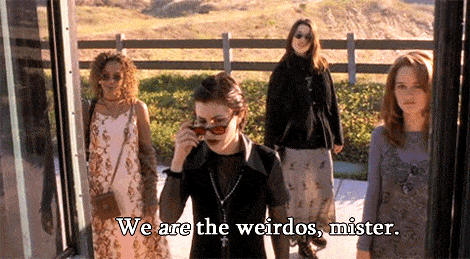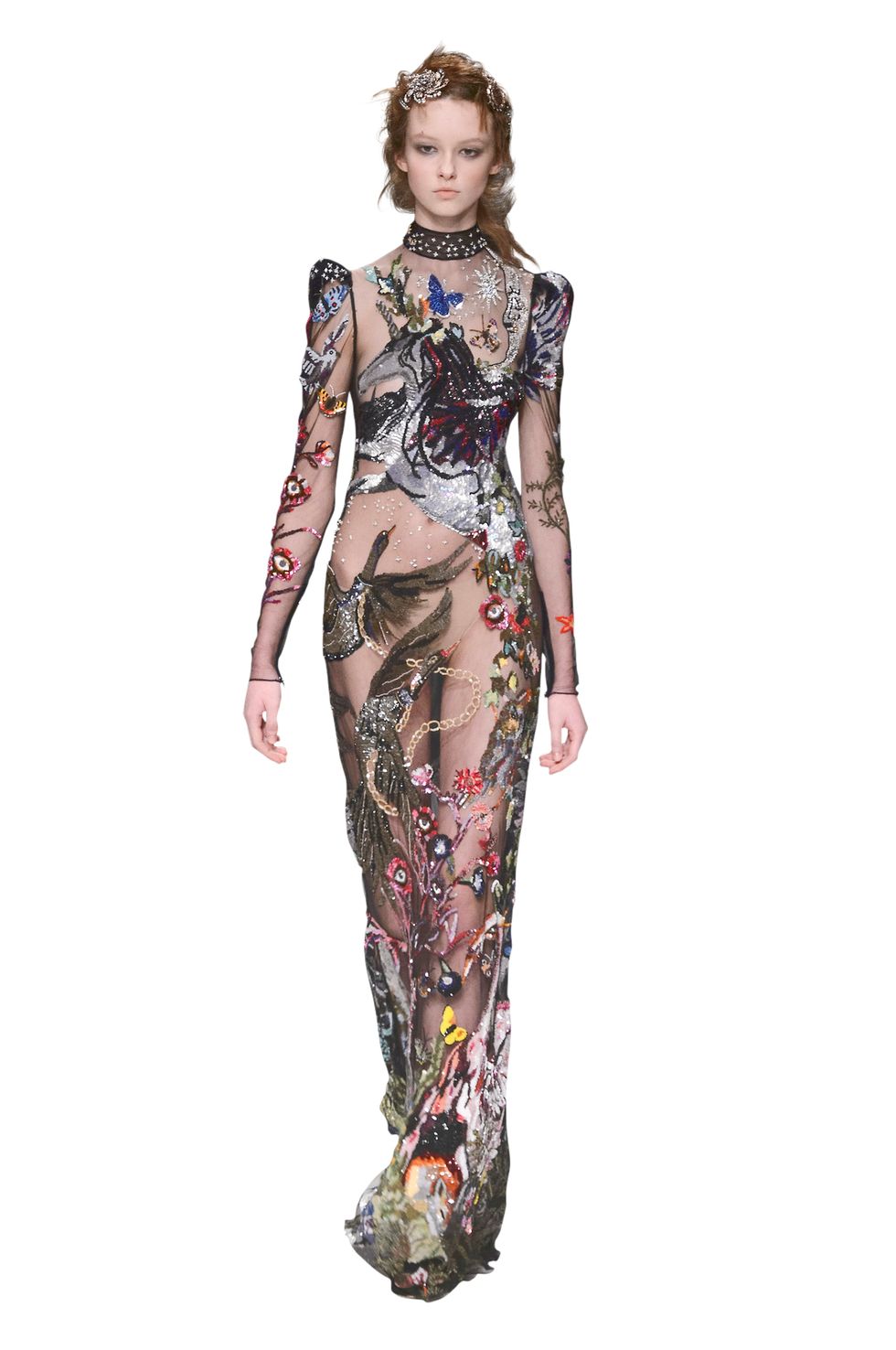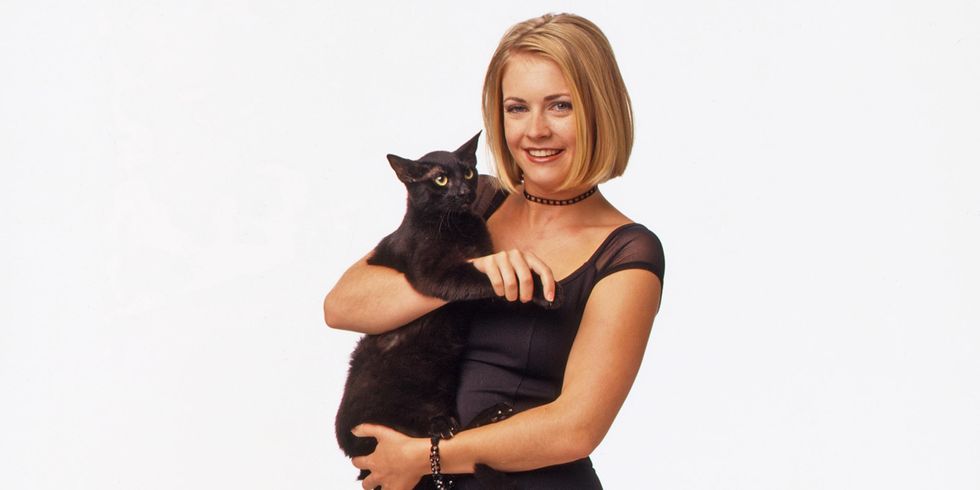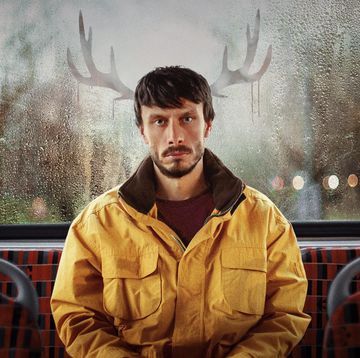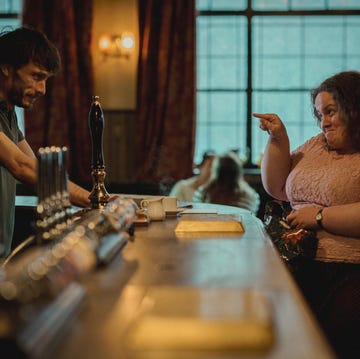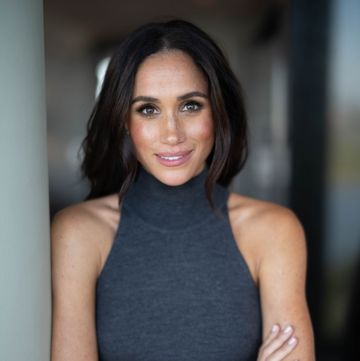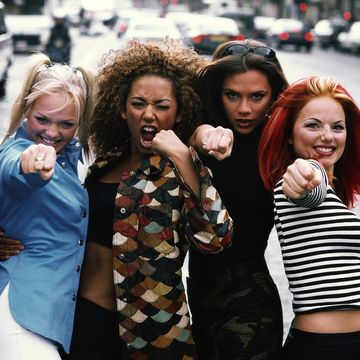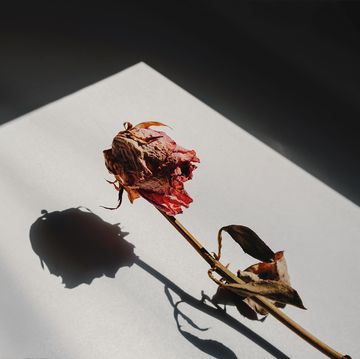It's midnight, 12 years ago. I'm in my attic bedroom in tears because our family dog, Charlie, is mysteriously sick. But I have an idea. Stealing a candle, a box of matches and the tiny schnauzer, I tiptoe back upstairs.
With an internet printout in hand, headed Healing Magick, I light the candle, say a few words over the confused dog, then stroke her while imagining a healing light sinking into her fur.
A week later, she's given the all clear, with the vet telling my parents that she's 'a very lucky dog'.
Fast forward 12 years, and I'm discussing my early witchcraft exploits with three actual witches I met via Facebook, all of whom run covens in south London. They're not at all how you'd expect your stereotypical black-caped witch to be.
Isabel, who runs the Brixton coven, is a glamorous, straight-talking deputy digital director at a not-for-profit organisation; Caroline, who heads up Tooting, is one of the smiliest people I've ever met and runs a successful music production business.
And Cherry, head of the Elephant and Castle coven, is a former bodyguard who worked for the military in Iraq.
They are Wiccans, which is not a synonym for witch, but the name given to those who practise a formalised and initiation-only type of witchcraft first shaped from disparate folkloric tradition in the New Forest in the late Thirties. But back to my sick dog.
'Do you know why that spell worked?' asks Cherry, who became a witch after a number of near-death experiences and coincidences she had while stationed in the Middle East.
'Your intention was so strong.'
'That's what magick and witchcraft is,' says Isabel, explaining that the 'k' in 'magick' is to differentiate between witches and magicians.
Isabel discovered the craft after years of making potions and casting spells as a child, delighted to find that, as she got older, there was a religion based on what she'd been doing. 'It's using your intention [a focused command of what you want to happen] to create something, to do something.'
If it sounds simple, that's because it is. And it's one of the reasons that witchcraft is on the rise right now and more apparent than ever across the creative industries.
Rapper Azealia Banks, who claims to have been practising for three years, showed us her brujería (witchcraft) cupboard on Instagram.
Singer Lana Del Rey called her Twitter followers to join her in a pagan anti-Trump ritual using specific dates corresponding to magickal moon cycles, while New York R&B artist Princess Nokia shot a breathtaking ode to witchcraft filtered through her African-Nuyorican heritage for her track Brujas.
And it's not just happening among musicians – the fashion world is also embracing the rise of the occult.
Preen's SS17 collection was overtly inspired by witchcraft, with co-owner Thea Bregazzi saying: 'We grew up with witches. There are a lot on the Isle of Man – people go to see them to cure sore throats, ailments like that.' Preen carried the paganism thread over into AW17, albeit in a subtler way.
Meanwhile, in Alessandro Michele's ready-to- wear Gucci show, models walked against the back- drop of a giant black pyramid, and Alexander McQueen's were cloaked in fur, feathers and gowns rich in faerie-magick motifs.
Kenya Hunt, ELLE fashion features director, who has several friends who practise various new-age religions, thinks the creative angle has helped the ascension of witchcraft: 'Before, those people would have been viewed as "someone on the fringes" – maybe your wacky aunt – but when I moved to New York, I saw just how many people practise [alternative religions].
These were high-powered people in creative industries. One was an editor-in-chief of a major publication. To a certain degree, witchcraft in music, culture and fashion has helped to normalise it.'
In the US, witchcraft in all its forms has exploded, so it makes sense that the UK is following suit. In Manhattan, Santería and Ifá are separate Afro-American religious practices in their own right that incorporate spiritism and magick, but witchcraft is the umbrella term that unites alternate practices, from Wicca to Voodoo.
Dotted around New York you'll find botanicas, shops selling folk-magick tools, with old women dressed in white offering card readings. If a person is going through a bad time, they might go to a botanica to find a candle with a specific meaning, or use ileke beads, which are like prayer beads.
But why is this happening now? Anna Biller, the director of 2016's The Love Witch – a feminist 'horror-thriller' with a Sixties aesthetic that I'd highly recommend, alongside The Craft and Practical Magic – thinks it's down to the times we're living in.
'The way religions are used depends on the concerns of the era,' Anna said in an interview with Lenny Letter. 'In the Sixties, I think a lot of witchcraft was about people exploring nudity, sexuality, the demonic, the beyond... for exploitation of drugs and for getting outside of Christianity.
I think today, all of witchcraft is very aligned with new age concepts about inner healing, meditating. People are getting into it for completely different reasons, like female empowerment, women finding their power as goddesses.'
Historically misunderstood – and an eternal symbol for female sexuality, hysteria and darkness – magick has no verifiable start date, but originated from a mesh of practices passed down through generations. It gained real traction in the UK in 1939, when a man fascinated by witchcraft, Gerald B Gardner, discovered a group of witches in the New Forest and wrote up their practices in a book called Witchcraft Today. He radically altered the popular opinion of witches as sex-crazed devil worshippers, and shaped folkloric tradition into what we now know as Wicca.
While there are many different forms of witchcraft, Caroline from the Tooting coven explains that you can also be a little bit of everything: 'Wicca is a tradition where you have to be initiated by a recognised Wiccan – one who has also been initiated – to be a Wiccan yourself. But there are Eclectic Witches who borrow elements of all traditions. Anyone can be a witch, if their intention is right.'
Like Princess Nokia, who draws on the Santería traditions, the new wave of young witches is very much eclectic – something that Professor Michael Hedstrom of the religious studies department at the University of Virginia says explains the reasons we're drawn to witchcraft now more than ever.
'A millennial today can access information about Catholicism, Protestantism, Judaism, Islam, Buddhism, Hinduism and various pagan beliefs with just a few clicks. This is both liberating and paralysing,' he explains. 'Having so many options creates a lot of anxiety about which religious beliefs they should choose. Spirituality allows them to avoid choosing one religion and combine elements from many.'
This certainly rings true; we're a generation of spiritualists, with new age concepts such as meditation, visualisation and mindfulness all in the mainstream. A study from a Christian research firm found that 72% of millennials were 'more spiritual than religious'*.
On a personal level, and as an agnostic, the eclecticism of witchcraft interests me far more than anything else on the faith market right now. Elisabeth Krohn, founder of London-based modern witchcraft magazine Sabat, which has to be reprinted after each quarterly release due to insatiable demand, believes part of its appeal lies in its 'cut-and-paste nature'.
'It's an open and collaged spirituality,' she tells me. 'I certainly don't want to throw the word "postmodern" around, but you can bring in elements from different traditions. You can be into Norse religion, for example, or Buddhism. It can be about your queerness, animal rights, the environment. That really is essential to anyone looking for spirituality today.'
Tilly Garcia, 27, a visual artist with an interest in the occult and Instagram following of 36.6K on her @_spirits account, agrees: 'I don't necessarily label myself as just a witch – I was raised without religion and so I had the freedom to find my own path – but I enjoy the occasional full-moon ritual. It involves meditation, cleansing crystals in salt water, burning palo santo (a sacred wood from Peru).
It's like sage, in that it's said to clear away energies. I also charge crystals with the moonlight and positive intentions depending on what I want to achieve that month. I do this just as I'd also partake in some elements of Buddhism.'
Tilly and Elisabeth are part of a growing online movement, where young people interested in magick and the spiritual can connect in ways that haven't previously been possible. While witches in the early Noughties had to make do with internet chatrooms, the witch of 2017 celebrates the visual aesthetic of witchcraft on Instagram, from beautiful spellcasting #flatlays to gothic-altar inspiration.
[instagram ]
🕯 🕯️🕯️#hedylamarr via @thegrimphantasm #witchcraft #witch #witchesofinstagramA post shared by SABAT MAGAZINE (@sabatmagazine) on Aug 2, 2017 at 11:54pm PDT
[/instagram]
Others, such as Rose Dumaine, who runs @harvestrosewitchery, have started selling magickal tools on the handmade-goods e-commerce site Etsy, including talismans, crystals, herbs and other tools to aid the urban witch. Her best-selling products are ileke beads, and she identifies as a witch, incorporating New Orleans Voodoo into her practice.
'You can make a ritual out of anything,' says Rose. 'Getting dressed in the morning, cooking dinner at night, or perhaps you create a small ritual every day by lighting a candle and sitting down with your tarot cards.' Eclectic, exploratory and with an eye for a top witch-based meme, the above are known as the #WitchesofInstagram.
'Social media has given witches all over the world the ability to connect, share and acquire knowledge and create a sense of community,' Rose explains. 'It's given a lot of "solitary witches" – those who don't practise in a coven, like me – the opportunity to not feel so alone.'
For Elisabeth, Instagram, like fashion, has helped to rebrand and normalise witchcraft: 'I discovered the witches of Instagram and realised there's this whole world happening out there that is very digital.
And Instagram is helping the rebranding of witchcraft from old warty women to strong powerful modern women, because of the visual culture we now live in and thrive on.'
The witchcraft aesthetic may help publicise the movement, but witches wouldn't be witches without spells. And a contemporary urban witch's spellcasting is as thoroughly modern as the hashtags, while maintaining the traditional values.
For example, most witches keep a personal book of 'shadows' – a scrapbook of what works for them, what doesn't, and what they'd like to try. Witches believe that energy resides throughout the natural world and can be harnessed; Rose swears by lighting sage and wafting it about to help both cleanse a room and yourself of negative energy.
Though Wiccans specifically swear an oath of secrecy never to reveal the rituals that go on within their covens, they're happy to chat about spells in general. 'Magick is about the time spent, building the energy, and focusing the energy, to release it into the universe,' says Caroline. 'Even a spell as simple as writing someone's name on to some paper and putting it in a freezer so they cool off – a classic – requires you to visualise and think while you're writing the name.'
Cherry adds: 'Just putting your intention into a candle, then blowing it out, is as powerful as any other spell you can think of, and we've all been doing that on our birthdays since we were little.'
Love spells are a little different. 'It's about casting a spell on yourself,' explains Isabel. 'If you put a spell on Josh, for example, Josh might be attracted to you, but he won't know why, and it can cause all kinds of free-will issues.
So you cast a spell to attract more love into your life, and if Josh is the right one, then he'll be there! If not... well, at least you didn't mess with things that could upset people.'
As well as the power of focusing their intentions, the south London witches I meet all talk about the link between feminism, femininity and witchcraft: 'Many witchcraft traditions are matriarchal in nature. You feel your own power when you're a witch.
You feel the power of the world and everything around you. You acknowledge others' power, but it does not affect the power you yourself hold. What's more feminist than that?'
'Witchcraft, like feminism, has a bad rep,' adds Tilly. 'In the same way that some people think of feminists as bra-burning man-haters, they think of witches as demonic hags – both have been so misunderstood, but I feel that is evolving.
Both witchcraft and feminism have to do with empowerment and the interconnectivity of us all.'
Who doesn't want to feel empowered and connected? I say we reclaim the pointy hat and take a bit of magick with us wherever we go. Get out into nature. Meditate. Light some sage after a bad day at work to clear your brain of negative energy.
Try a simple candle spell if you're in a fix. While I haven't thought about that period spent magicking family pets for a long time, the moment I got back after meeting the witches of south London, I put an order in for some sage. Because my intention is set: I'm using witchcraft to help me through these turbulent times.
This article originally appeared in the August issue of Elle UK, on newsstands now

